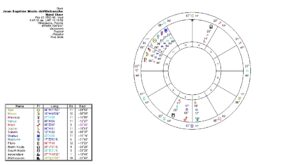 Jean Baptiste Morin de Villefranche (1583-1656) was a leading astrologer in 17th century France, with patrons like Cardinal Richelieu, Pope Urban VIII, France’s Queen Marie de Medici and Queen Kristina of Sweden, but he never received quite the acclaim he felt entitled to. He fumed over contemporaries who used what he considered deficient methods but who nevertheless enjoyed greater success. For 30 years he toiled over his masterwork, The Astrologia Gallica, yet he was never able to publish it. Finally, five years after his death, his patron Queen Marie Louise Gonzaga of Poland brought it into print.
Jean Baptiste Morin de Villefranche (1583-1656) was a leading astrologer in 17th century France, with patrons like Cardinal Richelieu, Pope Urban VIII, France’s Queen Marie de Medici and Queen Kristina of Sweden, but he never received quite the acclaim he felt entitled to. He fumed over contemporaries who used what he considered deficient methods but who nevertheless enjoyed greater success. For 30 years he toiled over his masterwork, The Astrologia Gallica, yet he was never able to publish it. Finally, five years after his death, his patron Queen Marie Louise Gonzaga of Poland brought it into print.
With Jupiter ruling the 9th of higher learning and publishing placed in its own sign of Pisces, Morin retained a college professorship for over 25 years. Jupiter trined his Mars and conjoined 3rd house ruler Mercury in Aquarius, and he could certainly write – Astrologia Gallica runs over 26 books and 800 pages! So what was the problem? Saturn.
 By the time Morin practiced in the mid-17th century, his Latin was going out of style and the work of Copernicus and Newton attracted more attention as the west drew closer to the scientific reductionism of the “Enlightenment.” Morin was a man who suffered for an expertise that no longer seemed relevant to many.
By the time Morin practiced in the mid-17th century, his Latin was going out of style and the work of Copernicus and Newton attracted more attention as the west drew closer to the scientific reductionism of the “Enlightenment.” Morin was a man who suffered for an expertise that no longer seemed relevant to many.
Jupiter conjoined his Sun at about a half a degree, with both in orb of conjoining Saturn in Pisces in the 12th house. Morin’s Moon, also in Pisces, conjoins Saturn more closely. If Jupiter lacked dignity, we might describe the situation as “too little, too late.” Instead, we have a seminal work that is still being read and translated over 400 years after publication, but only in parts and with a limited audience.
All of the 12th house planets increased Morin’s sense of isolation and seclusion, but gave him the opportunity and motivation to capture his thoughts. With Aries rising, Mars in cranky Cancer conjoined the low-point 4th house, quintiled the Ascendant and trined the Sun, Jupiter and Saturn in the 12th. His attacks on Descartes, Galileo, Cardan and others didn’t help his popularity. Today we can also see that Mars squares Pluto in the 12th, heightening his anger and frustration. But the 4th house placement goaded him toward a solid foundation, and with Mars’ trine to Saturn, ruler of the 10th, he succeeded in transmitting an astrological tradition over several centuries. Unfortunately, though, in keeping with Jupiter, the Astrologia Gallica is also just a little too big, complex and comprehensive.
With Jupiter conjunct Saturn ruling Morin’s 8th through 12 houses, this notable combination also activated events after his life. Jupiter and Saturn at 1 Taurus 36, conjoined his Ascendant on April 18, 1881, and 20 years later, on November 28, 1901, the conjunction in Capricorn closely conjoined his Midheaven.
At the turn of the century, French astrologer Henri Selva translated an abridged version of Morin’s 21st book on determinations, and included a commentary. The next Jupiter conjunct Saturn in 1921 fell at 26 Virgo 36 in Morin’s 6th house of helpmates and squared his 3rd-9th house Nodes. Austrian astrologers Captain Frederich “Sinbad” Schwickert (1837-1930) and Adolf Weiss, M.D. (1888-1956) together wrote their own explanation of Morin’s methods, a 5-volume work based on Astrologia Gallica’s Books 21 and 22 (synthesis and directions) called Bausteine der Astrologie (Liepzig 1925-27). Weiss fled the Nazis in the 1930s, moving to Brazil and finally Argentina, where he published a Spanish version of their work in 1938.
The Jupiter-Saturn conjunction of 1961 at 25 Capricorn fell in Morin’s 10th house and squared his Ascendant, again setting the stage for what would follow. Hungarian immigrant Zoltan Mason (1906-2002) opened his astrology bookshop in New York City in 1950. As he was fluent in both French and German, he may have initially encountered Morin in Europe through the earlier 20th century works.
Mason’s Ascendant was opposite Morin’s, and his Moon at 28 Libra closely conjoined Morin’s 7th house cusp, making him a partner. In 1974, Mason published an English translation of Morin’s Book 21, Astrosynthesis, by his student Lucy Little (a pseudonym as the woman’s family disapproved of astrology). The same year, a translation by Richard S. Baldwin was released by the AFA.
Another teacher of Morin’s technique was Gerhard Angel Houwing (1923-2009). According to Dave Roell, he was from Argentina though he may have been Dutch. Houwing began studying astrology before he turned 20, and was introduced to Morin in the 1950s through the German Bausteine. He resettled in Dallas in 1963, and his students included James Herschel Holden and Patti Tobin Brittain. Brittain wrote the Morin primer, Planetary Powers (1980). (See my review of Planetary Powers.)
Cornerstones of Astrology is an English version of the Spanish translation of Schwickert and Weiss’ Bausteine, published by the Sangreal Foundation, Inc. from Dallas in 1972. There is no indication of who translated the book, but Brittain tells us that Houwing was “instrumental” to the work. The short preface is attributed to Jan Meursing, which Roell believed was a pseudonym for Houwing.
In the early 21st century, after the Jupiter-Saturn conjunction at about 23 Taurus on 5/28/00 in Morin’s first house, Holden translated several parts of the book into English. Morin’s Moon and Saturn closely straddled Holden’s Ascendant, so he was able to connect with and express the long-obscured work. The AFA published a number of English translations of Astrologia Gallica’s books, many by Holden.
I will write more about Cornerstones of Astrology in a later post.
Morin’s chart is based on his own statements, with research by Tony Louis and Zoltan Mason.
Robert Corre has much on Morin on his Forum on Astrology.
More on Morin from the late Dave Roell at Astroamerica.com.
Philip Graves appears to have a rather complete list of works by or about Morin at Astrolearn.com (scroll down).

